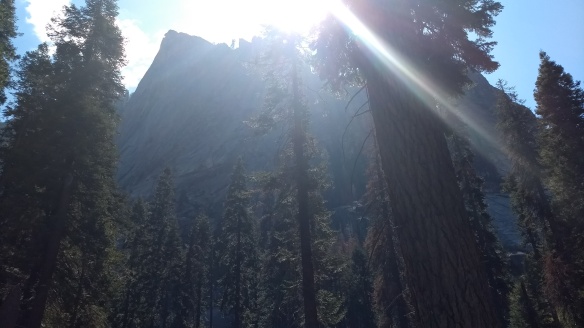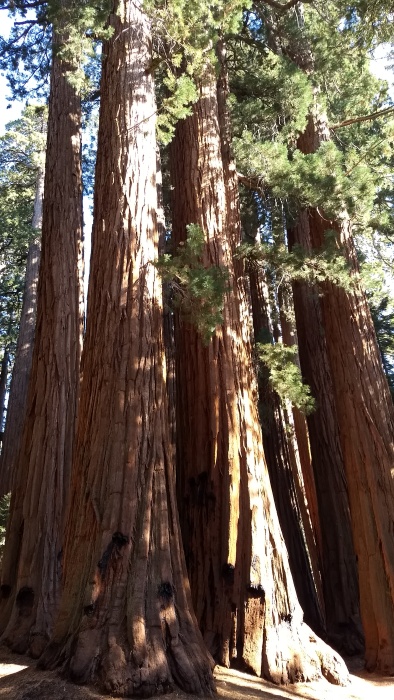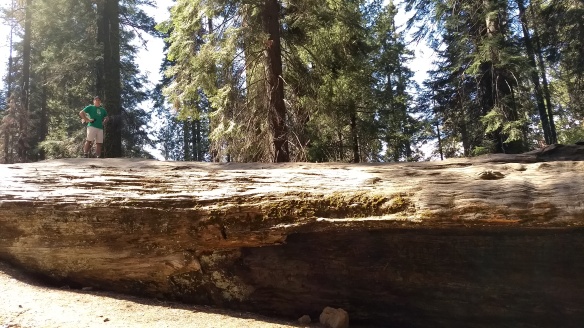
A few weeks ago, my husband and I hiked California’s Sequoia National Park. Its beauty was breathtaking. Thin air and a cloudless sky formed a haze of unreality. Skyscraper trees towered over us in the aptly named Giant Forest. Black tattoos branded their robust, ruddy trunks. Following well-tended paths atop a pine-needle carpet, we spoke in hushed tones like nervous children in a fairy tale wood. Our necks ached from craning to glimpse their tops from where we stood, far beneath their outstretched arms. Nature’s majesty made us feel small in the best way.
But fear almost kept me from this adventure. Traveling outside of my comfort zone makes me susceptible to scary whispers. Potential dangers rattled around in my mental backpack as we prepared for the journey: an airplane crash, a bear attack, a fall off the side of a rocky mountain cliff, an impending nuclear warhead reaching the west coast. They tempted me to sink my roots deeper into the solid ground of the known and to stay put.

Despite the worst-case scenarios that haunted my imagination, I pressed on to see these natural treasures firsthand. I wasn’t disappointed. My Midwestern eyes widened in disbelief as I used both hands to grip the pinecones-on-steroids that littered the forest floor. Up close, I marveled at the magnitude of the sequoias, wrapped my arms around a portion of their prickly girth, and breathed in the earthy musk of their perfume. We walked across a fallen giant large enough for a car to cross. Took pictures in the monstrous shadow of its gangly root ball. The reality of their presence inspired reverence like a photograph never could.

Reading the text printed on placards throughout the park, I learned that in the early part of the twentieth century, the superintendents of this national park practiced ongoing fire suppression in order to protect the sequoias. Their motives were good, at least on the surface. The goals were to preserve the natural beauty while also earning profits from tourists who flocked to see it. It seemed wise to limit or remove the risk of fire damage to the trees and the surrounding man-made structures. But over time, the forest started to die.
Scientists began to second-guess this strategy, suspecting that efforts to prevent all fires stunted growth and prevented regeneration. Human interference in the form of both invasive development and extreme fire suppression was robbing the trees of a healthy environment. Fires that did occur were becoming more catastrophic. Their research led to the eventual acceptance of a theory that once seemed counterintuitive: Some fire is necessary for growth in the lifecycle of the trees.
A sign along the path entitled “A Fiery Life” states: “Fire has influenced every sequoia in the Giant Forest. Over thousands of years, lightning fires have burned here as often as every 3-9 years.” I read on to discover: “Curved healing rings grow over wounds, restoring the trees’ protective surface. Every mature sequoia has healed many wounds. Most are caused by fire.”
Blazes brand and carve out sections of their towering trunks. But they continue to grow.
Another plaque listed “Fire’s Friendly Effects.” While fire kills some of the sequoias, it also:
- Heats and opens their cones, causing seeds to rain down
- Deposits seeds onto cleared soil fertilized by ash
- Kills insects and fungus that threaten seedlings
- Removes trees that compete for sunlight, moisture, and nutrients so others can thrive
- Renders the area less flammable for years to come so seedlings can take root
There is purpose in the process. Benefits result from the burning. Human attempts to control the forest’s environment threatened its very health and existence by preventing necessary fires.
I am guilty of the very same thing.
The forest reminded me that risk suppression is an ineffective method of fear management. Avoidance of unpleasant realities leads to unintended consequences.
Overprotected sequoias suffer from problems including “lack of mineral soil, inadequate soil moisture, plus low-light conditions under a dense forest canopy.” Fire ecologists have stated that “without fire or other kinds of disturbance, sequoia seeds either do not germinate at all or seedlings do not survive if germination does occur.” (Restoring Fire to the Sequoias, National Park Service Website)
Translated to soul-level: overprotection stunts our growth. We add fuel to an eventual catastrophic fire when we snuff out every potential spark. Symptoms may include: spiritual shallowness, blindness or tunnel vision, unchecked pride, and death. If I attempt to live pain-free, I’ll be insulated, isolated, and unchanged. When I let fear rule, it smothers both the bad and the good.
Long is the list of threats and dangers I try to suppress. Physical discomfort. Uncomfortable questions. Unpleasant news. Distasteful opinions. Hurt feelings. Bad memories. My own mistakes. Potential failure. And not only for myself, but for my children.
I reflected on fires I’ve already walked through: unexpected losses, injuries that took time to heal, disappointments, unanswered questions, discouragement, and conflicts with loved ones to name a few. When I’ve engaged and faced them head-on, they’ve been productive. By burning away my self-centeredness, pride, sense of entitlement, and the illusion of control, God has used them to help me grow. In the aftermath, I’ve been more receptive and responsive. Seeds of compassion, understanding, gratitude, and trust have taken root.
The dictionary definition of “life” is the condition that distinguishes animals and plants from inorganic matter, including the capacity for growth, reproduction, functional activity, and continual change preceding death. I have a long way to go, but to stay safe and static is not the way to really live.
Fires will come. If I spend my life obsessed with pain prevention, I’m wasting my energy. Better to allow the necessary fires to do their work. If I don’t, I’ll be consumed. Mature trees bear their scars proudly, as proof they have persevered. Change comes slowly, but no experience is wasted if we’re planted in good soil.



Loved your latest about necessary fires. Very moving. Well done.
Love, Dad
LikeLike